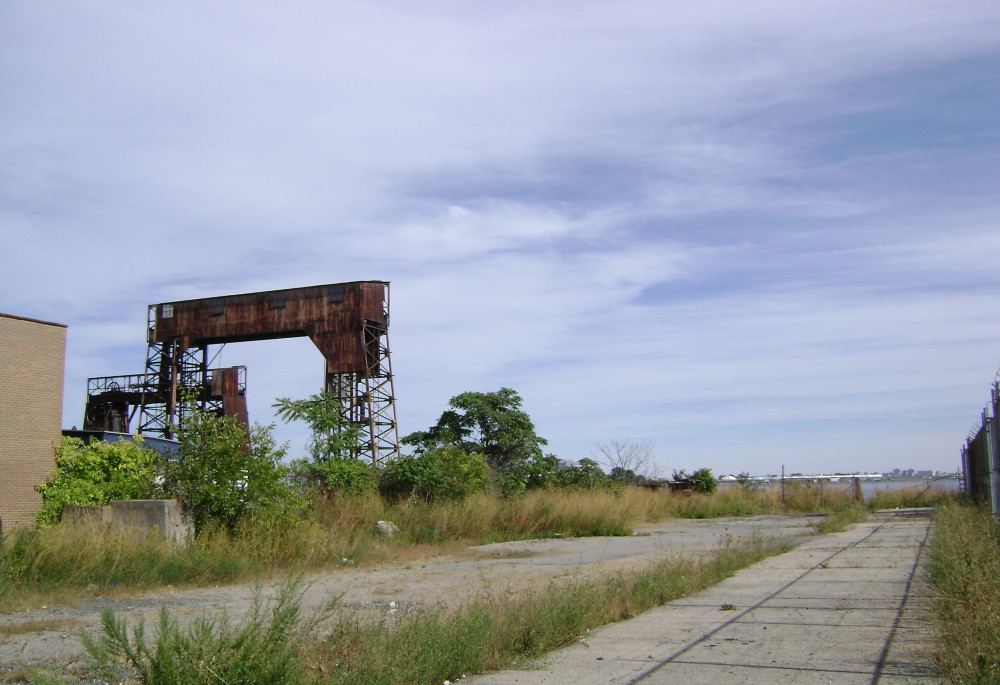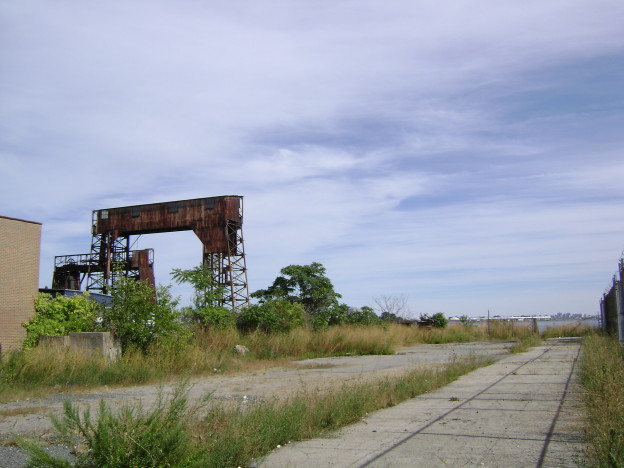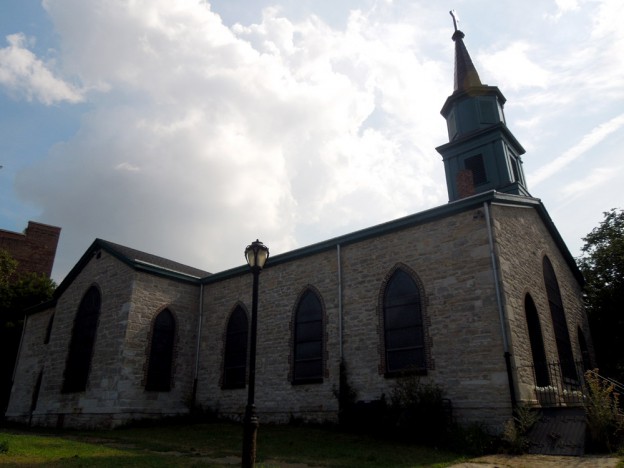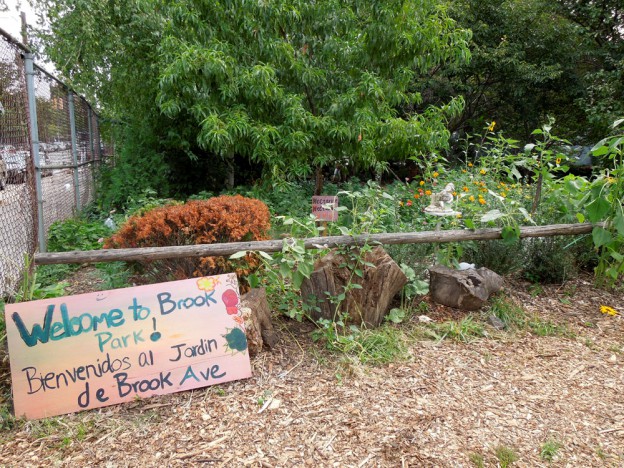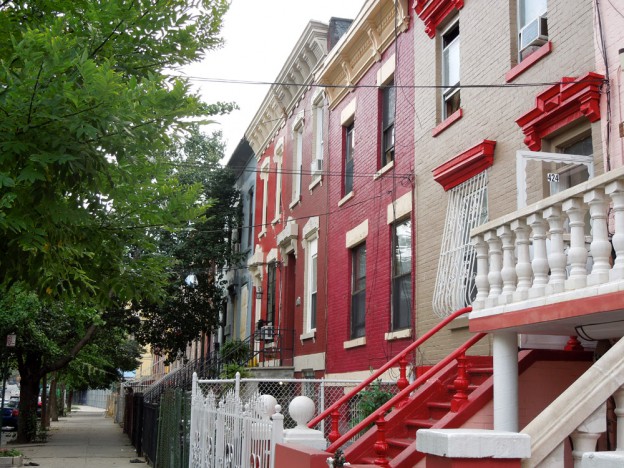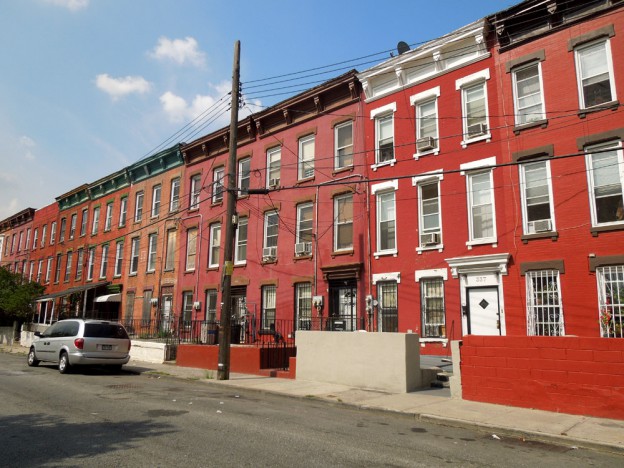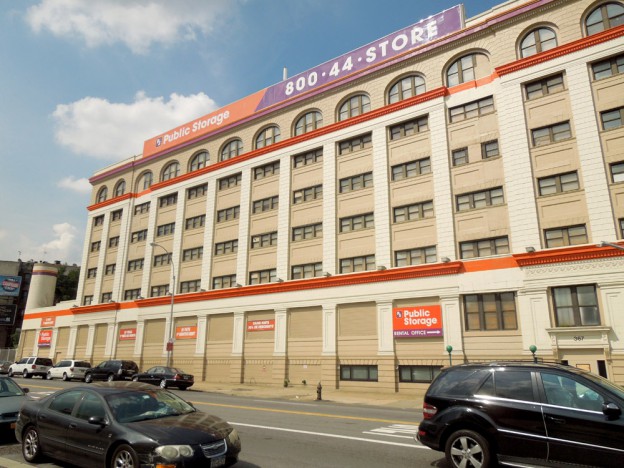The Port Morris section of The Bronx was once part of Morrisania, which was established as a seaport in 1842 by Gouverneur Morris, Jr., son of United States founding father Gouverneur Morris. In the 1850s, the area’s waterfront developed as an industrial center with tenants such as stone works and furniture and piano factories. Around the turn of the 20th century, Port Morris was part of a network of industrial waterfront districts in the southern Bronx, northern Queens and northern Manhattan. As there were not yet bridges connecting these parts of the city, ferries were the primary means of crossing the waterways.
One of the ferry depots along this network was at East 134th Street in The Bronx, for which a pair of large ferry bridges or “gantries” was constructed in 1948. The ferry bridges were discontinued in the 1960s and have been left to deteriorate. Inland of the industrial waterfront, developers constructed apartment buildings and commercial blocks to serve factory employees. Today the neighborhood has retained this layout.
To learn more about Port Morris and the 134th Street Ferry Bridges click here
158 Bruckner Boulevard;
McKim, Mead & White;
1936–37|
The Bronx Grit Chamber was built as a sewage disposal plant for The Ward’s Island Sewage Treatment Works, New York City’s first major effort to alleviate water pollution. As one of the world’s largest and most modern facilities of its kind, it was capable of treating one fifth of the city’s sewage. Designed in McKim, Mead and White’s signature neo-Classical style, the building’s architecture recalls other contiguous civic works. Its symmetrical front façade centers on a large arched window flanked by four rusticated pilasters with alternating courses of Roman brick and limestone. Other ornaments include limestone moldings and a foliated keystone at the top of the arch.
The Bronx Grit Chamber is a designated New York City Individual Landmark.
295 St. Ann’s Avenue;
Unknown architect;
1840–41|
Erected by Gouverneur Morris, Jr. as a family memorial on his rural estate, this is the oldest extant church in The Bronx. The building features a simple fieldstone Gothic Revival base and a green-painted wood Greek Revival tower with an octagonal belfry, low spire and simple cross. In the church’s crypt and graveyard lie the remains of illustrious members of the Morris family, including Gouverneur Morris, Sr., Judge Lewis Morris, first Governor of New Jersey, and Major General Lewis Morris, a member of the Continental Congress and signer of the Declaration of Independence.
The St. Ann’s Church and Graveyard is a designated New York City Individual Landmark.
Brook Park is named for the “Saw Mill Brook” that once flowed through here. The Friends of Brook Park was founded in 1999 to educate the public on local environmental resources. The organization runs shore clean-ups, boat tours of the waterways and farming lessons, as well as advocates for environmental justice, waterfront access and green space development.
William O’Gorman & William;
Hornum;
1877–1900|
This historic district, located on East 139th and East 140th Streets between Willis and Brook Avenues, is one of the oldest rowhouse developments in The Bronx, where the rowhouse typology is rare in comparison to other parts of the city. The houses were designed by two architects who, in some cases, collaborated. The houses on the north side of East 140th Street form a whimsical row in a mix of styles, including Dutch/Flemish pediments.
Mott Haven East is a New York City Historic District.
Originally Willis Avenue Methodist Episcopal Church;
330 Willis Avenue;
George W. Kramer, 1900|
This beige brick Gothic Revival church is punctuated by white-painted wood window surrounds, pediments and moldings. Its richly colored stained glass is a particularly beautiful feature of this corner building.
William O’Gorman;
1897|
These 24 neo-Grec rowhouses on the south side of East 142nd Street were designed by the same architect responsible for many of the houses in the Mott Haven East Historic District. They were constructed of brick with stone ornaments and bracketed cornices. In recent years, some of them have been re-clad or painted in an array of bold colors.
This park takes its name from a church that once stood on Alexander Avenue and East 142nd Street. In the park’s north end is Janes’ Hill, which is named for Adrian Janes, a partner of Janes, Kirtland & Company Iron Works, whose factory stood northwest of the park. Amongst the company’s achievements were casting the architectural ironwork for Central Park’s Bow Bridge and both casting and erecting the iron dome for the Capitol Building in Washington, D.C. in 1863.
321–355 Concord Avenue;
Ca. 1886–1921|
These elegant rowhouses are made of brick with brownstone ornaments and most have retained their historic bracketed cornices. One of the most marked characteristics of this row is its uniform color palette, as almost all of the houses either display their original red brick or have been painted a shade of red.
367 Southern Boulevard;
Unknown architect, ca. 1900|
The Ward Bread Company, founded by Irish immigrant Hugh Ward in 1849 on the Lower East Side, was a major company with factories all over the country, including one in Brooklyn and this one in The Bronx. The six-story white glazed terra-cotta building featured a large smokestack with the company’s name painted on it. The smokestack has been truncated and the company name painted over. In the early 20th century, the company revolutionized the baking process, employing new technology to bake bread in a mechanized assembly line. In the 1920s, Hugh’s grandson William attempted to monopolize the American baking market, using dirty business tactics. To distance itself from the negative press and its tarnished reputation, the company assumed the name of one of the companies it acquired: Wonder Bakeries, makers of Wonder bread.
